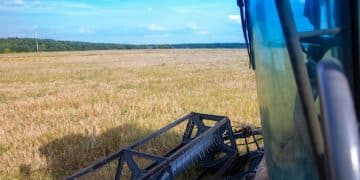US Agricultural Land Values: Investor Insights on the 3.5% Increase

The recent 3.5% rise in US agricultural land values presents both opportunities and challenges for investors, signaling a dynamic market influenced by factors like commodity prices, interest rates, and government policies, demanding a strategic approach to navigate potential risks and rewards.
The agricultural land market in the United States has always been a significant indicator of the nation’s economic health. Recently, US agricultural land values have experienced a notable 3.5% increase. This shift raises important questions and opportunities for investors seeking to understand the dynamics of this ever-evolving market.
Understanding the Recent Increase in US Agricultural Land Values
The recent 3.5% increase in US agricultural land values is a noteworthy development that warrants careful examination. This uptick can be attributed to various interrelated factors, each playing a crucial role in shaping the current market landscape. Understanding these factors is essential for investors looking to make informed decisions.
Factors Contributing to the Increase
Several factors have contributed to the recent increase in US agricultural land values. Let’s delve into some of the most significant drivers behind this trend:
- Increased Commodity Prices: Higher prices for crops like corn, soybeans, and wheat have boosted farmers’ incomes, making them more willing to invest in land.
- Low Interest Rates: Until recently, low interest rates made borrowing money for land purchases more affordable, increasing demand and driving up prices.
- Government Support Programs: Government subsidies and support programs provide financial stability to farmers, encouraging investment in agricultural land.
- Growing Demand for Agricultural Products: Increasing global population and changing dietary preferences have led to higher demand for agricultural products, supporting land values.
These elements interact to create an environment where agricultural land becomes more valuable. Investors must consider these drivers as they evaluate opportunities in this market.

In conclusion, the increase in US agricultural land values is a multifaceted phenomenon driven by commodity prices, interest rates, government support, and growing global demand. Understanding these factors is crucial for both investors and agricultural stakeholders.
The Current State of the US Agricultural Land Market
To fully grasp the implications of the recent increase, it’s essential to assess the current state of the US agricultural land market. This involves understanding the trends, regional variations, and underlying economic factors that shape the market dynamics.
Regional Variations in Land Values
Agricultural land values vary significantly across different regions of the United States. Factors such as soil quality, climate, water availability, and local market conditions influence these regional differences. Here are a few examples:
- Midwest: States like Iowa, Illinois, and Indiana typically have high agricultural land values due to fertile soil and favorable growing conditions for corn and soybeans.
- Plains: Kansas, Nebraska, and the Dakotas often feature lower land values compared to the Midwest, primarily because of drier climates and varying soil quality.
- South: States such as Texas, Georgia, and Florida have diverse agricultural activities, including cotton, peanuts, and citrus, leading to varied land values depending on the specific crop and region.
- West: California, Washington, and Oregon exhibit a wide range of land values influenced by factors like water rights, specialty crops, and proximity to urban areas.
Understanding these regional differences is vital for investors aiming to identify opportunities and manage risks in the agricultural land market.
In summary, the US agricultural land market is diverse, with significant regional variations influenced by factors like soil quality, climate, and local market conditions. Investors should carefully consider these variations when making investment decisions.
Impact of Interest Rates and Inflation on Land Values
Interest rates and inflation play a critical role in shaping agricultural land values. Fluctuations in these macroeconomic factors can significantly impact the affordability of land purchases and the overall profitability of agricultural operations.
The Relationship Between Interest Rates and Land Values
Interest rates have a direct impact on the cost of borrowing money for land acquisitions. When interest rates are low, farmers and investors can secure loans at more affordable terms, increasing demand and driving up land values. Conversely, rising interest rates make borrowing more expensive, which can dampen demand and potentially lead to a decline in land values.
Inflation’s Influence on Agricultural Land
Inflation affects agricultural land values through several channels. Increasing input costs, such as fertilizers, seeds, and fuel, can erode farmers’ profit margins, making it more challenging to invest in land. On the other hand, rising commodity prices driven by inflation can boost farmers’ incomes, providing them with more capital for land purchases. The net effect of inflation on agricultural land values depends on the relative magnitude of these opposing forces.

Strategies for Navigating Interest Rate and Inflation Risks
Investors can employ several strategies to mitigate the risks associated with interest rate and inflation fluctuations. These include:
- Hedging: Using financial instruments like futures and options to protect against adverse price movements in commodity markets.
- Diversification: Spreading investments across different types of agricultural land and geographic regions to reduce exposure to specific risks.
- Long-Term Leases: Securing long-term leases with fixed rental rates to provide stable income streams and protect against inflation.
In conclusion, interest rates and inflation significantly impact agricultural land values. By understanding these dynamics and implementing appropriate risk management strategies, investors can navigate the challenges and capitalize on opportunities in the agricultural land market.
Opportunities for Investors in US Agricultural Land
Despite the complexities and challenges, the US agricultural land market offers several compelling opportunities for investors. These opportunities range from direct land ownership to indirect investments through various financial instruments.
Direct Land Ownership
Direct land ownership allows investors to generate income through crop production, livestock farming, or leasing the land to farmers. The potential benefits of direct land ownership include:
- Appreciation: Land values can appreciate over time, providing capital gains for investors.
- Rental Income: Leasing land to farmers can generate a stable stream of rental income.
- Tax Benefits: Agricultural land ownership may qualify for certain tax benefits, such as deductions for property taxes and depreciation.
Indirect Investments in Agricultural Land
Indirect investments offer investors exposure to the agricultural land market without the responsibilities of direct land ownership. These can include:
- Real Estate Investment Trusts (REITs): REITs that specialize in agricultural land can provide investors with a diversified portfolio of properties.
- Agricultural Funds: Mutual funds and exchange-traded funds (ETFs) that invest in agricultural companies and related assets.
Indirect investments offer liquidity and diversification benefits, making them an attractive option for investors who prefer a more hands-off approach.
In summary, the US agricultural land market presents various opportunities for investors, including direct land ownership and indirect investments through REITs and agricultural funds. Investors should carefully consider their risk tolerance, investment goals, and time horizon when evaluating these options.
Potential Risks and Challenges in the Agricultural Land Market
While the agricultural land market offers attractive investment opportunities, it is essential to acknowledge the potential risks and challenges that investors may encounter.
Environmental Risks
Environmental factors such as droughts, floods, and soil degradation can significantly impact agricultural productivity and land values. Climate change poses a growing threat to agricultural regions, potentially leading to reduced yields and increased volatility.
Market Volatility
Commodity price fluctuations, trade disputes, and changes in government policies can introduce volatility into the agricultural land market. These factors can impact farmers’ profitability and their ability to invest in land.
Regulatory Risks
Changes in environmental regulations, land use policies, and agricultural subsidies can affect the value of agricultural land. Investors should stay informed about these regulatory developments to assess their potential impact on their investments.
In conclusion, the agricultural land market is subject to various risks and challenges, including environmental factors, market volatility, and regulatory changes. Investors should conduct thorough due diligence and implement risk management strategies to mitigate these risks.
Strategies for Successful Agricultural Land Investment
To succeed in the agricultural land market, investors need to develop a well-informed strategy that aligns with their investment goals and risk tolerance.
Conducting Due Diligence
Thorough due diligence is essential before investing in agricultural land. This involves assessing the soil quality, water availability, climate conditions, and local market dynamics. Investors should also evaluate the legal and regulatory environment to identify potential risks and opportunities.
Building Relationships with Local Experts
Establishing relationships with local farmers, agricultural consultants, and real estate professionals can provide valuable insights into the agricultural land market. These experts can help investors identify attractive investment opportunities and navigate the complexities of the industry.
Implementing Sustainable Farming Practices
Sustainable farming practices can enhance long-term productivity and profitability. These practices include:
- Crop Rotation: Rotating crops can improve soil health, reduce pest infestations, and increase yields.
- Conservation Tillage: Minimizing soil disturbance can reduce erosion, conserve water, and enhance soil fertility.
- Water Management: Implementing efficient irrigation techniques can conserve water and reduce the risk of drought-related losses.
In conclusion, successful agricultural land investment requires thorough due diligence, strong relationships with local experts, and a commitment to sustainable farming practices.
| Key Aspect | Brief Description |
|---|---|
| 📈 Recent Increase | US agricultural land values rose by 3.5%, influenced by commodity prices and interest rates. |
| 🌱 Regional Variations | Land values differ across regions due to soil quality, climate, and local markets. |
| 💰 Investment Opportunities | Investors can consider direct land ownership or indirect investments through REITs and funds. |
| ⚠️ Potential Risks | Environmental factors, market volatility, and regulatory changes pose risks to investments. |
Benefits of Agricultural Land?>
▼
The primary drivers include increased commodity prices, low interest rates (until recently), government support programs, and growing global demand for agricultural products.
▼
Regional variations significantly impact land values due to differences in soil quality, climate, water availability, and local market conditions across states.
▼
Potential risks include environmental factors like droughts and floods, market volatility in commodity prices, and regulatory changes affecting land use and subsidies.
▼
Investment options include direct land ownership for farming or leasing, and indirect investments through Real Estate Investment Trusts (REITs) and agricultural funds.
▼
Investors can mitigate risks by conducting thorough due diligence, diversifying investments, implementing sustainable farming practices, and building relationships with local experts.
Conclusion
In conclusion, the recent 3.5% increase in US agricultural land values signals a dynamic market with both opportunities and challenges for investors. By understanding the drivers behind this increase, considering regional variations, managing risks, and implementing informed strategies, investors can navigate the agricultural land market successfully and capitalize on its long-term potential.





